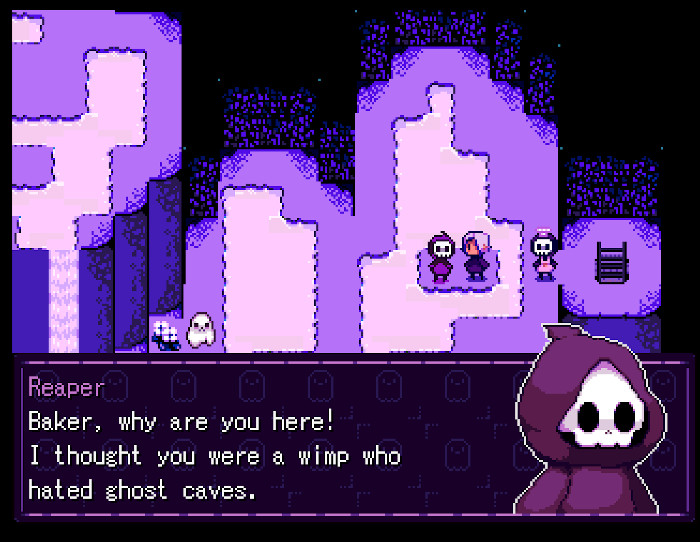Grimm's Hollow
-
www.wikidata.org/wiki/Q96418507
Online stores itch.io Steam - 2019 video game
-
grimm-1639299266647.jpg
The battle-shy baker is tasked by Grimm to accompany Lavender as part of her training as a reaper.Credit: ghosthunter. Fair use.Source: own screenshotSource data licensing:
Data from Wikidata is available under Creative Commons CC-0.
lib.reviews is only a small part of a larger free culture movement. We are deeply grateful to all who contribute to this movement.Reviews
Please sign in or register to add your own review.
Being a reaper doesn't have to be grimAfter you die, if your spirit is out of balance, you spend time in limbo as a ghost with too much energy, or as a reaper with too little. Reapers collect the excess energy of ghosts, helping them to pass on—until they have collected enough energy to pass on themselves.
And so is is that a young girl named Lavender finds herself waking up in Grimm’s Hollow as a reaper tasked by the grim reaper (AKA Grimm) with collecting ghosts. Lavender is understandably skeptical of this assignment, but plays along in hopes that she may find her brother Timmy.
Grimm’s Hollow is a freeware indie game by developer ghosthunter, made with the popular RPG Maker software. Much of the game consists of exploring three caves, in which you encounter fellow reapers and fight ghosts in turn-based battles with quick-time events.

The battle-shy baker is tasked by Grimm to accompany Lavender as part of her training as a reaper. (Credit: ghosthunter. Fair use.)The combat system can be a bit frustrating at first, but once you master it, you’re unlikely to have any issues until the final battle. What makes Grimm’s Hollow a gem of a game is the attention to the story, the worldbuilding, and the characters.
For example, to heal, you collect treats such as “Spooky Cookies” and “Deathlicious Donuts”, all rendered in beautiful pixel art. The baker has made a special deal with Death that he can avoid ghost battles if he just keeps the goods coming.
Grimm’s Hollow features four different endings. If you lose the final battle, make sure to retry until you get at least one of the good endings. The game also offers save slots, but you’re unlikely to need them once you’ve mastered the initial learning curve. All in all, it’s a 3-4 hour experience, and a wonderful treat that should not be missed.
Although this is a Windows game, I played it on Linux using Steam/Proton with only one minor issue: the top GNOME menu bar stayed visible in full-screen mode (without overlapping with the game’s contents).
If you love the game and want to express your appreciation for the developer, you can purchase an art pack on Steam or itch.io.
